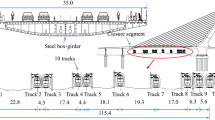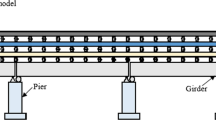Abstract
An analytical model is presented to study vertical dynamic response of the ballastless track on long-span plate-truss cable-stayed bridges based on an explicit dynamic analysis method. In the model, the train, ballastless track and bridge are treated as a coupled vibration system with interaction. By simulating the dynamic process of the system, this paper discusses the distribution law of dynamic responses of the bridge deck and the bed slab. It shows the necessity of a base plate for the ballastless track on the long-span plate-truss cable-stayed bridge. Comparison of the influence of different train speeds and stiffness of the elastic vibration-damping pad on the dynamic responses of the bridge deck and the bed slab is also made. The reasonable stiffness value of elastic vibration-damping pad is proposed.
Similar content being viewed by others
References
He H W. Ballastless Track Technology (in Chinese). Beijing: China Railway Publishing House, 2005. 1–5
Zhai W, Xia H, Cai C, et al. High-speed train-track-bridge dynamic interactions-Part I: Theoretical model and numerical simulation. Int J Rail Transportation, 2013, 1: 3–24
Zhai W, Wang S, Zhang N, et al. High-speed train-track-bridge dynamic interactions-Part II: Experimental validation and engineering application. Int J Rail Transportation, 2013, 1: 5–41 Timoshenko S. On the forced vibrations of bridges. Philos Mag Ser, 1922, 43: 1018–1019
Mise K, Kunii S. A theory for the forced vibration of a railway bridge under the action of moving loads. Q J Mech Appl Math, 1956, 9: 195–206
Frýba L. Dynamics of Railway Bridges. London: Thomas Telford, 1996
Arvidsson T, Karoumi R. Train-bridge interaction-a review and discussion of key model parameters. Int J Rail Transportation, 2014, 2: 147–186
Zhai W M, Cai C B. Train/track/bridge dynamic interactions: imulation and applications. Veh Syst Dyn, 2002, 37: 653–665
Zhai W M, Cai C B, Wang K Y. Numerical simulation and field experiment of high-speed train-track-bridge system dynamics. Veh Syst Dyn, 2004, 47: 677–686
Cheng Y S, Au F T K, Cheung Y K. Vibration of railway bridges under a moving train by using bridge-track-vehicle element. Eng Struct, 2001, 23: 1597–1606
Zhang N, Zhou S, Xia H, et al. Evaluation of vehicle-track-bridge interacted system for the continuous CRTS-II non-ballast track slab. Sci China Tech Sci, 2014, 57: 1895–1901
Biondi B, Muscolino G, Sofi A. A substructure approach for dynamic analysis of train-track-bridge system. Comput Struct. 2005; 83: 2271–2281
Zhu S Y, Fu Q, Cai C B, et al. Damage evolution and dynamic response of cement asphalt mortar layer of slab track under vehicle dynamic load. Sci China Tech Sci, 2014, 57: 1883–1894
Lou P, Yu Z W, Au FTK. Rail-bridge coupling element of unequal lengths for analyzing train-track-bridge interaction systems. Appl Math Model, 2012, 36: 1395–1414
Wu Y S, Yang Y B, Yau J D. Three-dimensional analysis of train-rail-bridge interaction problems. Veh Syst Dyn, 2001, 36: 1–35
Guo W W, Xia H, De Roeck G, et al. Integral model for train-track-bridge interaction on the Sesia viaduct: Dynamic simulation and critical assessment. Comput Struct, 2012, 112–113: 205–216
Livermore software technology corp. Ls-dyna Keyword User’s Manual. California, 2007
Fan J J. Modern Railway Track (in Chinese). 2nd eds. Beijing: China Railway Publishing House, 2004
Chen G, Zhai W M. A new wheel/rail spatially dynamic coupling model and its verification. Veh Syst Dyn, 2004, 41: 301–322
Li Y L, Qiang S Z, Liao H L, et al. Dynamics of wind-rail vehicle-bridge systems. J Wind Eng Ind Aerod, 2005, 93: 483–507
Klasztorny M, Szurgott P. Modeling and simulation of bridge-track-train systems at high service velocities with LS-DYNA. In: 12th International LS-DYNA Users Conference, Detroit, 2012
Ministry of Environmental Protection of China. GB10071-88, Measurement Method of Environmental Vibration of Urban Area. Beijing: China Standard Publishing House, 1989
Author information
Authors and Affiliations
Corresponding author
Rights and permissions
About this article
Cite this article
Li, Y., Su, Y., Xia, F. et al. Vertical dynamic response of the ballastless track on long-span plate-truss cable-stayed bridges. Sci. China Technol. Sci. 58, 236–247 (2015). https://doi.org/10.1007/s11431-014-5750-7
Received:
Accepted:
Published:
Issue Date:
DOI: https://doi.org/10.1007/s11431-014-5750-7




